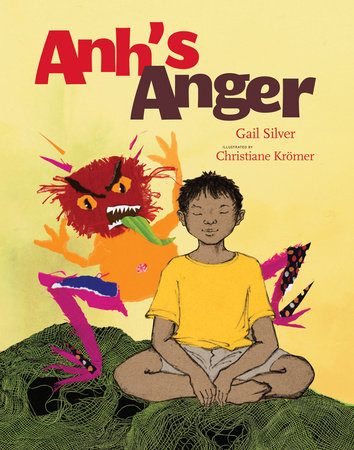This wonderful and engaging 1st book in a trilogy that includes
Steps and Stones and Peace, and
Bugs and Understanding, gives children and caregivers a concrete practice for dealing with anger and other difficult emotions.
In
Anh’s Anger, five-year-old Anh becomes enraged when his grandfather asks him to stop playing and come to the dinner table. The grandfather helps Anh fully experience all stages of anger by suggesting that he go to his room and, "sit with his anger." The story unfolds when Anh discovers what it means to sit with his anger. He comes to know his anger in the first person as his anger comes to life in full color and personality. Anh and his anger work through feelings together with humor and honesty to find a way to constructively release their thoughts and emotions and to reach resolve with Anh’s grandfather.
The story is beautifully illustrated with handmade collages by New York artist and childrens book illustrator Christiane Kromer. Each collage is a mix of paper, acrylic, and cardboard, and found materials. The materials reflect the connection between the characters and their environment and are indicative of the wide range of emotions that come together in the story.
Anh’s Anger teaches children that it is okay to feel angry, and shows the technique, often used by child therapists, of externalizing the emotion. Through taking time to "sit’ with his anger, a young child is able to see his anger and talk to it and together they move through the journey of experiencing the different stages of anger until the feeling subsides and finally resolve.
Anh’s Anger differs significantly from other books on anger resolution techniques in showing that the child is able to talk about what transpired and accept responsibility for hurtful things that he may have said or done.
The author’s intention is to help parents understand that there is an alternative to "time out’s" as a means of helping children to express themselves when feeling angry, while providing children with a mechanism for internal dialogue during a "time out" or when "sitting" with their anger.
Through reading the story, children will learn to acknowledge anger when it arises, understand the cause of their anger, and ultimately feel safe expressing themselves and accepting accountability for their actions when appropriate. By learning these skills, children, will grow comfortable with them and carry them into adulthood with ease and confidence.
Gail Silver is a former child ddvocate attorney and founder of Yoga Child, a Philadelphia-based yoga studio, where she teaches, writes music and meditations, and develops the Yoga Child school-based yoga and mindfulness curriculum. Silver was the recipient of a Parents’ Choice Recommended Award in 2007 for the Yoga Child recording
A Peaceful Place Inside. She is a script consultant for the yoga segment of
The Good Night Show on PBS Kids Sprout. Silver resides in Philadelphia with her husband and three children.
Christiane Krömer was born in 1963 in Germany. She moved to Brooklyn, NY, in the early '90s where she received a BFA in Illustration from Parsons School of Design. Her previous work includes
Flowergirl Butterflies (a Capitol Choice "Noteworthy Book for Children 2004),
The Treehouse Children, (Simon & Schuster), and
God the Parent's Blessings.
"This is one of the best books I’ve come across to help a child not only understand their anger but to develop ways to work with that anger."—Kayla Michelle,
Macaroni Kid
"We all know how challenging it can be to help a child deal with the powerful energy of anger. No matter how deep our reserves of compassion and patience are as parents, we also seek tools.… The book clearly offers an Eastern approach and draws from the wisdom of an expert on the matter: Vietnamese Buddhist monk and peace activist Thich Nhat Hanh. Thich Nhat Hahn instructs that the way we approach anger is to first accept responsibility for it and actually embrace it. 'Your anger is not your enemy, your anger is your baby.' Our first task, he says, is to accept it as 'a mother accepts her child.' Nhat Hanh views emotion as organic and therefore mutable. So, like refuse, which we change to compost, we can change our anger into love. All this is comes through beautifully in Gail Silver’s book for children." —Phoebe Vreeland,
The Children's Book Review

















